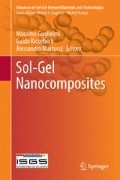Abstract
Nanocomposites have become an important class of materials as they allow to combine somehow contradictory materials properties in a complementary way in one material. The use of inorganic-type nanoparticles in sol-gel-derived or polymer-type matrix by wet chemical synthesis approach allows to incorporate solid-state physical properties of ceramics even into transparent polymers without decreasing transparency in the visible range. The chapter presents key results and structure–property relationships of nanocomposite films usable to produce functional coatings or paints. Concepts such as control of interfacial adhesion , particle surface modification for compatibilization and synthesis parameters that determine specific morphologies are presented. Mechanical properties in dependence on the morphology as well as dynamic mechanical behaviour in dependence on nanoparticle/matrix interaction and particle size of the nanoparticulate inclusions are covered.
Access this chapter
Tax calculation will be finalised at checkout
Purchases are for personal use only
References
ORMOCER is a registered trademark from Fraunhofer organisation in Germany describing inorganic-organic hybrid polymers
NANOMER is a registered trademark from Leibniz-Institute for New Materials gGmbH in Germany describing nanocomposite coatings and compact materials
Brinker CJ, Scherer GW (1989) Sol-gel-science. Academic Press, New York
Hench LL, Ulrich DR (1984) Ultrastructure processing of ceramics. Glasses and composites. Wiley, New York
Hench LL, West JK (1990) The sol-gel process. Chem Rev 90:33
Schmidt H, Philipp G (1984) New materials for contact lenses prepared from Si- and Ti-alkoxides by the sol-gel process. J Non-Cryst Solids 63:283
Schmidt H (1985) New type of non-crystalline solids between inorganic and organic materials. J Non-Cryst Solids 73:681
Mark JE, Ning YP, Jiang CY, Tang MY (1984) Particle sizes of reinforcing silica precipitated into elastomeric networks. J Appl Polym Sci 29:3209
Sun CC, Mark JE (1987) In situ generation of reinforcement in polyisobutylene networks. J Polym Sci B Polym Phys 25:1561
Huang HH, Orler B, Wilkes GL (1987) Structure property behavior of new hybrid materials incorporating oligomeric species into sol-gel glasses. Macromolecules 20:1322
Landry CJT, Coltrain BK, Fitzgerald JJ (1993) Poly(vinyl acetate) silica filled materials—material properties of in-situ vs fumed silica particles. Macromolecules 26:3702
Schaefer DW (1989) Polymers, fractals, and ceramic materials. Science 243:1023
David IA, Scherer GW (1957) An organic-inorganic single phase composite. Chem Mater 1995:7
Rayleigh LJW (1871)
de Oliveira PW (2006) PhD thesis, Institute for New Materials
Becker-Willinger C (1998) PhD thesis, Institute for New Materials
Elias HG (1992) Makromoleküle, Band 1, Grundlagen, 5.Auflage, Hüthig & Wepf Verlag, Basel
Droste DH, DiBenedetto AT (1969) J Appl Polym Sci 13:2149
Plueddemann EP (1982) Silane coupling agents. Plenum Press, New York
Kluke M (2006) PhD thesis, Institute for New Materials
Schmidt H, Scholze H, Kaiser A (1984) J Non-Cryst Solids 63:1–11
Zhang Z, Sakka S (1999) J Sol-Gel Sci Tech 16:209–220
W. Noll (1968) Chemie und Technologie der Silicone. Verlag Chemie
Elias HG (1992) Makromoleküle, Band 2, Technologie, 5.Auflage, Hüthig & Wepf Verlag, Basel
Guth E (1945) J Appl Phys 15:20
Author information
Authors and Affiliations
Corresponding author
Editor information
Editors and Affiliations
Rights and permissions
Copyright information
© 2014 Springer Science+Business Media New York
About this chapter
Cite this chapter
Becker-Willinger, C. (2014). Nanocomposite Films. In: Guglielmi, M., Kickelbick, G., Martucci, A. (eds) Sol-Gel Nanocomposites. Advances in Sol-Gel Derived Materials and Technologies. Springer, New York, NY. https://doi.org/10.1007/978-1-4939-1209-4_5
Download citation
DOI: https://doi.org/10.1007/978-1-4939-1209-4_5
Published:
Publisher Name: Springer, New York, NY
Print ISBN: 978-1-4939-1208-7
Online ISBN: 978-1-4939-1209-4
eBook Packages: Chemistry and Materials ScienceChemistry and Material Science (R0)

